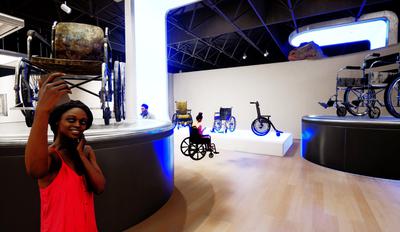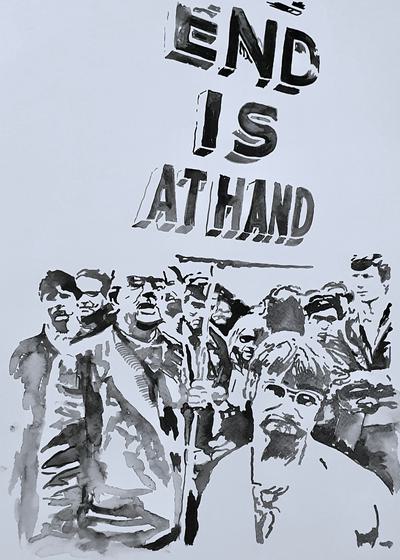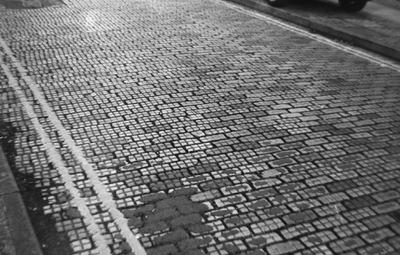We can't afford to work for love
Commissioned by Axis as part of the 'Artist Exploitation' series in January 2024

Lauren McLaughlin, 'Gold Bars', Collage on perspex, 2017
On a hot day last July, I was at London’s The Feminist Library trawling through their Wages for Housework archives with sheer delight and despair. It was the first time I had been away from home (without my son) since long before the pandemic, made possible by a small (£500) travel grant I had received from the Stephen Palmer Travel Awards. As I thumbed through the campaign bulletins, newspaper clippings and letters from their 1970’s-90’s archives, an image of a picket line placard reading ‘We Can’t Afford To Work For Love’ grabbed my attention. It summed up everything I had been thinking about, and the activism that has underpinned my career for over a decade. My practice has centred on making visible the unseen and unpaid labour of mothering work, and supporting mothers in the arts. Yet I’ve done so within the confines of an art world system that is also reliant on unseen, unpaid labour. [1]
It is difficult for me to separate talking about art and talking about motherhood, as the two experiences have been so interlinked in my life. I’ve written previously about these links[2], and how both roles share so many similarities. Both are centred on care, compassion, nurture, creativity and love, and both are undervalued by society and exploited by capitalism. The economy relies on the unpaid work of carers[3], and the art world relies on the unpaid labour of artists[4], but we are discouraged from speaking up about it for fear of being labelled bad mothers or ungrateful artists.
We exist within a system that assumes that making art is a ‘labour of love’ that does not require remuneration, and it is this assumption that underpins cultural policy, funding structures and perpetuates a culture of artist exploitation.[5] It ensures that the arts sector is a place where only the most privileged can exist, and with all the love in the world, those that can’t afford to be there are pushed to the margins, or out altogether.[6]
There has been ample research into the precarious and exploitative nature of employment in the cultural industries[7], and recent research shows that artists are earning well below the living wage[8], despite the arts generating £126 billion toward the UK economy[9]. My own career was springboarded by an unpaid “work experience” placement in a commercial gallery, offered through the jobcentre a few months after I graduated. After an incredibly challenging experience at art school, and the years of hard work it took to get there as a young mum (not to mention the £42,000 student debt), I was determined not to let all that hard work be in vain. A combination of sheer determination and naive optimism has kept me working in the arts ever since.
Like many artists, this has involved a juggling act of part-time employment, freelance roles, short-term project funding, studio work, small commissions, workshops and talks, made more challenging by the fact I had to work around the school hours and the limited childcare available to me as a solo mother. In an industry that already pays artists well below the living wage, it was certainly not enough to raise a child and therefore like the majority of solo parents, my low pay was propped up by a failing benefit system that does not work for freelancers.[10] As someone who is deemed to be from a ‘socio-economically disadvantaged’ background, the messages we are given tell us that we need to be grateful for any opportunity that is presented to us; they are doing us a favour, and we are lucky to be here at all. So for a long time, I felt like I didn’t have the right to speak out, and so I just accepted any offer I was given despite the knowledge that I was worth so much more.
While artist exploitation is something that affects nearly all artists, it's much more difficult for women, those from working class backgrounds, mothers, disabled people, those who identify as LBGTQ+ and those from the global ethnic majority to develop careers when there are multiple intersectional barriers at play.[11] Feeling frustrated at the barriers I had to endure in developing my own career, I founded Spilt Milk as a way of creating more accessible opportunities and visibility for mothers, who have historically been excluded from participating in the arts.[12] This involved running a number of socially engaged, childcare supported projects with young working-class mums, alongside curating exhibitions for professional artist-mothers through a dedicated member network. With the knowledge that arts funding was short-lived and hard to get, I was encouraged to go down the route of social entrepreneurship to explore ways to create a sustainable social business model. While I received a huge amount of support to do so; through accelerator courses, free business support, and two start up grants, I ran every one of those projects between 2017 - 2020 without paying myself. It is actually a strict condition of these start-up funds: you can use it to pay for any necessary costs, but by no means are you allowed to pay yourself a wage. Although not as blatant, Arts Council funding relies on a similar model: in order to receive project funding, you are required to either have ‘match funds’ in place, and/or have a track record of project delivery and preliminary work, i.e. you have to have done a heck of a lot of unpaid labour before you can even apply. These funding models only work for those that have the financial capacity and privilege to be able to work for free, and excludes those from low-income backgrounds from even starting out. Or like me, forced to balance multiple paid jobs, working seven days a week to survive, ultimately resulting in a high burnout rate.
Like most social entrepreneurs, I wanted to use my own experience of a particular societal problem to create a solution so that others wouldn’t have to face the same barriers. Yet the problem is, I’m not an entrepreneur, I’m an artist. Increasingly, socially engaged artists are being relied on by policymakers to plug the widening gaps in social care, community and healthcare sectors, and to strengthen social inclusion.[13] While the positive benefits of arts participation are being highlighted more and more,[14] the artists delivering this work are doing so within exploitative funding structures that do not provide proper care or compensation to artists. Eleonora Belfiore’s recent research highlighted that even when socially engaged projects do get the funding they need, artists are working significantly more hours than they are paid for, and shouldering a huge ‘hidden cost’ of delivering the work financially, emotionally and psychologically.[15]
While I recognise that setting up Spilt Milk was a conscious choice fuelled by the desire to make a positive difference in the sector, and that I have much more privilege than many others do, it has still come at a huge personal cost. By the start of 2020, I was beginning to burn out. By the end of March 2020 I had been made redundant from my part-time gallery job and had all my freelance contracts suspended. Without furlough or savings and not being entitled to the Covid self-employment scheme, I was one of those statistics that slipped through all of the safety nets. A few months later, I got served an eviction notice, forcing my son and I to move out of the city we had called home due to the rising and unaffordable rents. Just as it is impossible to talk about art without talking about mothering, it is impossible to talk about artist exploitation without talking about the wider systemic failures that disproportionately affect artists: the housing crisis, the cost of living crisis, the healthcare crisis, the funding crisis…I could go on. All of these issues are interconnected and produce an environment where low-income artists become more and more vulnerable.
Four years on, I’ve gained a Masters Degree, secured some more funding, got a new part-time job, and continue to juggle multiple freelance roles in a political and economic environment that gets more and more desperate by the week. So why am I still here? It’s a question that I really struggled with last year as my son turned 18. The guilt of not being able to provide him with a better, more financially stable childhood kept me awake at night. Did I make the right choices? Would things have been better if I wasn’t an artist? After 12 years of Tory austerity, a pandemic and now a cost of living crisis that has pushed 4.2million children into poverty,[16] I assume we never had much of a chance no matter what sector I worked in. So more importantly, the question I remind myself of now is: why am I an artist? I can’t imagine a life without it. Art has given me beautiful friendships and a sense of belonging. It has allowed me to explore and communicate complex emotions, grow in confidence, feel less isolated, and helped me to understand the world from many different perspectives. These are things that cannot be monetised.
As long as capitalism prevails, so will exploitation, but the antithesis of capitalism is care. While these exploitative systems exist, we can’t afford to work for love, but we can work toward envisioning a different future, one where an ethics of care is at the centre, and where artists are valued. Just pay us properly so we can get started.
Notes
In this article I use the terms ‘mother’ ‘mothering’ and ‘motherhood’ inclusively. I recognise that the route to, and experience of mothering is diverse and many people can identify with the role of ‘mother’ regardless of gender.
Citations
[1] Industria, Structurally F–cked, (Online, a-n The Artists Information Company, 2023), p36.
[2] Lauren McLaughlin, Spilt Milk: Matriarchal Structures for Art World Participation, (Online, Witte Rook, 09.03.2022).
[3] Carers UK, Unpaid care in England and Wales valued at £445 Million per day, (Online, carersuk.org, 03.05.2023).
[4] Industria, Structurally F–cked, (a-n The Artists Information Company, 2023), p37.
[5] Lindsay Seers, Is artists’ exploitation inevitable or is it just a question of identifying effective, enduring, preventative frameworks?, Axisweb, 16.06.2023), p32-3.
[6] James Tapper, Huge decline of working class people in the arts reflects fall in wider society, (Online, The Guardian, UK,10.12.2022).
[7] Mark Banks, Creative Justice: Cultural Industries, Work and Inequality, (London, Rowman & Littlefield, 2017).
[8] Industria, Structurally F–cked, (a-n The Artists Information Company, 2023), p39.
[9] Heather Evennett, Contribution of the arts to society and the economy, (UK Parliament, 26.01.2024).
[10] Harriet Williamson, The Shitty Reality of Universal Credit as a Freelancer, (Vice, 06.06.2019).
[11] Industria, Structurally F–cked, (a-n The Artists Information Company, 2023), p26.
[12] Hettie Judah, How Not to Exclude Artist Mothers (and other parents), (London, Lund Humpries, 2023).
[13] Eleonora Belfiore, Who Cares? At what price? The hidden costs of socially engaged arts labour and the moral failure of cultural policy, (European Journal of Cultural Studies, Vol 25(1), 2022), p62.
[14] Charlotte Duck, From developing our brains to keeping us healthy: the positive effects of art, (The Guardian, UK, 17.11.2023)
[15] Eleonora Belfiore, Who Cares? At what price? The hidden costs of socially engaged arts labour and the moral failure of cultural policy, (European Journal of Cultural Studies, Vol 25(1), 2022), p62.
[16] Action for Children, Where is child poverty increasing in the uk?, (online, action for children, 01.01.2024).

Lauren McLaughlin March 2024
Artists
Tags, Topics, Artforms, Themes and Contexts, Formats
Share this article
Helping Artists Keep Going
Axis is an artist-led charity supporting contemporary visual artists with resources, connection, and visibility.


